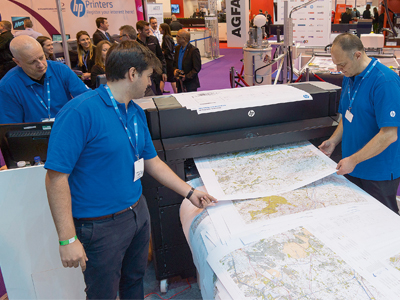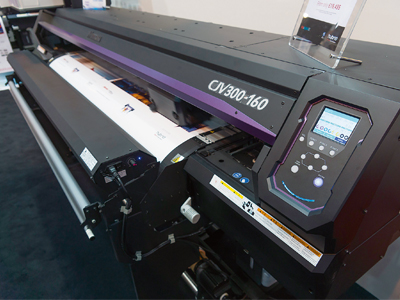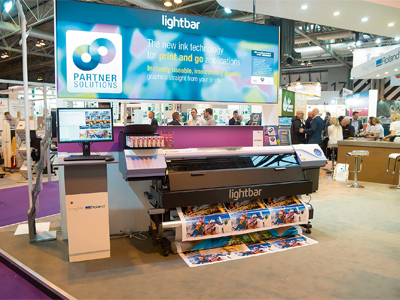A partnership deal with Roland DG saw CSL’s Lightbar models on several stands.
Simon Eccles visited the UK’s annual large format digital print show at the NEC, and enjoyed the chance to see everything in one spot.
A late blast of wintry weather did not deter visitors to last month’s Sign & Digital Show, held as usual in Birmingham’s NEC. Visitor numbers were up by 12% on last year, exceeding 6800 unique visits, with about 350 returning on more than one day.
Many were in a buying mood. Inktec made a Jetrix printer sale within the first hour during day one. Perfect Colours confirmed more than 20 HP Latex 300 printer sales and Radecal reported more than 20 CNC and laser machines sold over the three days. Resolute DTG said it had made £100,000 of sales and PrintMax sold more than 20 printers before the end of the show.
Event director Rudi Blackett said that this year’s show was 20% bigger than in 2014, with 190 exhibitors of which 40 were complete newcomers to the event and some, like William Smith, were returning after an absence. ‘In the past we’d have companies like Vutek, NUR, Scitex Vision etc with their own stands, but since they were taken over by EFI or HP there have been fewer separate companies,’ Mr Blackett pointed out. ‘However, this year we’ve gained CMYUK for the first time, showing EFI Vutek. HP is a big supporter too – last year it sold a lot of the new Latex 300 printers here.’
New kit
While there were plenty of newcomers, announcements from the big manufacturers were a little sparse, as some were apparently waiting for the larger pan-European FESPA show in Cologne during May. What was new was significant though, with first UK showings for the latest printers and a baby cutting table from Mimaki, the big Agfa Anapurna 3200iRTR rollfed UV machine, Jetrix’s new 3.2 metre RX3200 rollfed UV printer, Mutoh’s baby UV flatbed and a preview of HP’s speedy PageWide XL single-pass inkjet printer.
CMYUK had never attended Sign & Digital under its own banner before, though it had been there in association with EFI, whose Vutek large format inkjets it resells. Robin East, managing director of CMYUK, said: ‘We used to do a lot of magazine ads, but those days have gone. Everyone does e-shots. So it’s back to face-to-face. This is the de facto national show, and we’re on the “inside front cover”, next to the entrance.’
The market for large format is changing too, he said: ‘The economy is picking up, but we find we’re not just selling to print service providers, as lots of people are bringing work inhouse that they’d have outsourced before. With increased quality we see a lot going into vertical market niches that we always thought should be interested.’
Lightbars everywhere
In last month’s Digital Printer we looked at Colorific’s Lightbar conversion, which allows solvent-UV hybrid inks to be printed and cured on converted eco-solvent inkjets. Managing director Nick Wintle hinted at bigger news to come, and at the show this was revealed to be a major partnership with Roland DG, with new-build systems available through Roland resellers. Colorific is now calling itself CSL, with Colorific and Lightbar presented as brands for its UV curing lamps and inks.
Roland was announcing two new Partner Solutions products for the UK and Ireland. Lightbar was one and the other was the Sabur Diva, a direct-to-textile printer based on Roland’s fast 1.6 metre XF-640 inkjet. Sabur’s modifications allow it to print on very thin fabrics without distortion.
Roland DG’s other big news had to wait until the week after the show: Brett Newman has been promoted to managing director of the UK company, while former incumbent Jerry Davies is now MD of Roland DG EMEA (see People, page 72).
Fujifilm as usual combined its inkjet hardware with its euromedia consumables operation. It was demonstrating an Acuity Select flatbed UV printer alongside an Acuity LED 1600 roll printer. The flatbed was being used with Fuji’s own UVijet KV flexible thermoforming UV ink on plastic sheets. These were then formed on a vacuum frame to produce car-shaped models with a variety of pre-printed patterns. Although Fuji is not selling thermoforming equipment, it showed it in the demoes: the 3D mapping software is made by Quadraxis and the vac-former is by CR Clark.
Clarity Software is steadily broadening the scope of its Clarity Professional MIS, which was developed for signage companies from the start. ‘Clarity is now a world, not just one product,’ said marketing manager Emerson Welch. At Sign & Digital it was demonstrating a new Vehicle Wrap estimating module for the first time, prior to launch around now. ‘It calculates very accurately the panel sizes and stock requirements for small, medium and large vehicles,’ Mr Welch explained. ‘It includes the number of panels, the cost of the printer, ink coverage and time taken. It makes sure you get the top margin when you take on a job. This helps people diversify into vehicle wrapping and work out how to price.’
Showing for the first time was Tim Bell from Desigandprinting.com, near Reading, who is introducing Mnumi.com, a Polish-developed cloud-based web-to-print and MIS, to the UK market. It uses WordPress to build storefronts, linked to Mnumi’s back end MIS and database.
Cutting and creasing
Cutting tables were something of a theme at the show. Familiar names included AG-CAD, Aristo, DYSS, Esko Kongsberg and Zünd. Friedheim showed a Lasercomb ProDigi NEO cutting table with a 2.5 x 1.7 metre bed.
There for the first time was Blackman & White, keen to emphasise its UK manufacturing credentials for its multi-function flatbed tables. Based in Maldon, Essex, it exports 50% of its production, with one of its most spectacular builds being a 60 metre machine to cut out material for a Chinese airship manufacturer.
It launched more conventionally sized but still substantial 3.2 x 3.2 metre Versa-Tech tables into the graphics market a year ago and has sold 30 so far. These can be fitted with knife and laser cutters, plus creasing or routing tools. A new option puts an inkjet on the head, though the market for this is aerospace composite components, said commercial director Eiko Ichikawa White.
Mimaki made cutting tables even before it got into inkjets. Its latest CFL-605RT is a very compact model, intended to complement its UJF family of A2 and A3 UV flatbed printers. This takes sheets up to oversized A2, with a range of cutting and creasing functions.
A more unusual digital cutter was demonstrated by Micrographics. The £4500 Obelisk Turbo S is a digitally-driven CNC hot wire cutter for XPS or LPS building insulation foam in standard 600 x 1200 mm sheets. It holds the sheets vertically, so it is very compact. It will make lettering and other shapes up to 100 mm thick. The waterproof foam can be painted with water-based or acrylic paints and Micrographics was showing hollow shapes with simple LED arrays inside to give effective and cheap lighting effects.
PageWide revealed
HP sometimes appears under its own name and other times it supports one of its resellers. This year was a bit of both, with an HP stand across the aisle from its big distributor Art Systems. The big draw was the first sight of the new PageWide XL inkjet, based on fast single-pass head technology. Initially there will be four models, all with 40 inch (1016 mm) widths but with different configurations and speeds. The fastest will manage 23 linear metres per minute (for up to 30 A1 sheets). Prices were not revealed, but the cost per unit area is predicted to be approximately half that of a fast toner plan printer. The first model will ship in September.

HP demonstrated its forthcoming PageWide XL printing maps and posters at very high speeds.
While PageWide XL is extremely fast (top models are almost twice as fast as the 42 inch wide Memjet OEM printers, which have previously been the fastest things on the market), so far the quality is not a match for the latest Memjet heads with their tweaked firmware. To be fair, it is mainly aiming at the plans and maps market but the claim that it will handle basic poster work is a bit optimistic. The company is hinting that there will be future graphics versions in the family, though it will not confirm that they will use the High Definition Nozzle Architecture greyscale heads recently announced for the big T-series commercial web presses.
The Memjet OEMs at the show were the Océ ColorWave 900 from Canon and the RTI Vortex 4200, which was sharing the CMYUK stand. Three of RTI’s fast colour printers have recently been installed by the UK Hydrographic Office, which is using them to print about 300 nautical charts per hour, per machine, on special media.
Canon was also introducing its latest 42 inch ColorWave 700 printer with a starting price of £35,000. Despite the name this is not Memjet based but uses Océ’s CrystalPoint solid ink technology. Although it looks much the same as previous models, this one is aimed at display graphic work and is a lot more flexible in its media handling as well as offering better quality, said Dominic Fahy, Canon UK’s business group manager for display graphics and supplies. ‘It’s always been good for plan papers but it now does other media such as roll-up display film, fine linen, wallpaper and polypropylene banner. It will print on almost any roll media up to 0.8 mm thick. A new large takeup roller option on the back lets it handle longer banners.’ It is faster than a solvent inkjet, he pointed out, with throughput up to 200 square metres per hour and instant drying.
Repro Sales & Repairs was showing a new Chinese 1.8 metre wide hybrid roll/rigid media inkjet, the Mei Tu MT-R180, which has two Epson based print heads, running either eco-solvent or UV cured inks as CMYK x 2 or CMYK + White. A unique feature is a continuous nylon vacuum belt for media transport, which can take rolls and sheets side by side if needed. It can print edge-to-edge, allowing full coverage of rigid panels with no need for lamination or trimming.
Another newcomer was Pixel Digital Printers from Hungary, which was showing its Pixel.Jet UV-LED cured roll/sheet convertible hybrid printer for the first time in the UK. A 1.6 metre wide version was on show but there is also a 3.2 metre version, with a true flatbed on the way. Managing director Zoltan Ladi said he is looking for distributors.
Latest Mimakis
Hybrid Services, the UK distributor for Mimaki, had examples of the new replacements for the JV33 and CJV30. There are now four types, each with a choice of four widths from 810 to 1600 mm. The JV150 and faster JV300 are solvent or dye sub printers, priced from below £10,000 to £20,000. The CJV150 and CJV300 are printer cutters with the same choice of sizes.
Also demonstrated on the Hybrid stand was the last year’s JFX200, a flatbed UV printer with LED curing, plus, for the solvent rollfed models, the relatively new silver metallic ink, SS21, which is notably shinier than the older eco sol types. There is a new white too.
Colourgen sells Epson and Mutoh printers as well as inks and media. It had just got hold of Mutoh’s ValueJet 426UV baby UV flatbed a week before the show – this was originally announced last year but took longer than expected to come through. It is an A3+ model with a keen price of about £15,000, undercutting the equivalent Mimaki and Roland models. Its maximum media height of 70 mm may prove a bit low for the target market of giftware, though it takes golf balls and pens quite happily.

The CJV300 is the faster of the two new Mimaki printer-cutters.
Colourgen was also showing the latest cutter from Kala, the XY 1650. This costs £13,950 and speedily trims and slits printed rolls up to 1.65 metres into smaller rectangular sheets (it is not a shape cutter therefore).
Textiles continue to grow in importance, with the big printer makers all having examples at the show, often adapted signage models. The Dutch company Hollanders only makes textile printers and was showing a new ‘entry level’ 2.5 metre direct digital dye sublimation textile printer, the ColorBooster 250. This costs around £92,000, compared to its earlier 3.2 metre model that costs double that. Hollanders also makes ColorBooster DS, a double-sided dye sub printer that works on special spun polyester that does not bleed though as long as it is heat-fixed immediately. The main target market for this is flags.
Intricate lasering
Trilogy Lasercraft was exhibiting for the first time at Sign & Digital, after its directors visited the show last year. It offers laser cutting machines for either intricate paper work (such as business stationery, greetings cards and the like), or for presentation panels and awards, giftware etc, or large format profile cutting of thicker media such as acrylics and wood.
Caslon had a small stand showing some of its established toner-foiling and card cutting systems. New to us was the Maxit Adhesive System, which applies a thin hot-melt adhesive layer to the back of printed sheets: this will adhere to plastics, wood and metal but will not rub off on your fingers.
Landor Associates was particularly promoting its Surface Appeal range of four media that can transfer images onto difficult surfaces including glass, plaster, stone and highly textured surfaces.
This year’s Sign & Digital demonstrated that there is still demand for a properly focused printing trade show, despite the disappointment of last year’s wider-ranging Ipex. The HP preview in particular demonstrated the value of shows to visitors, who can see a whole bunch of rival systems in the same place: here they only had to walk a few metres to compare the PageWide XL print quality and speed with a pair of rivals that use Memjet printheads. You do not get that with single-manufacturer roadshows or showrooms.





